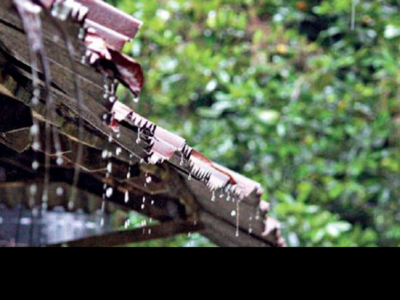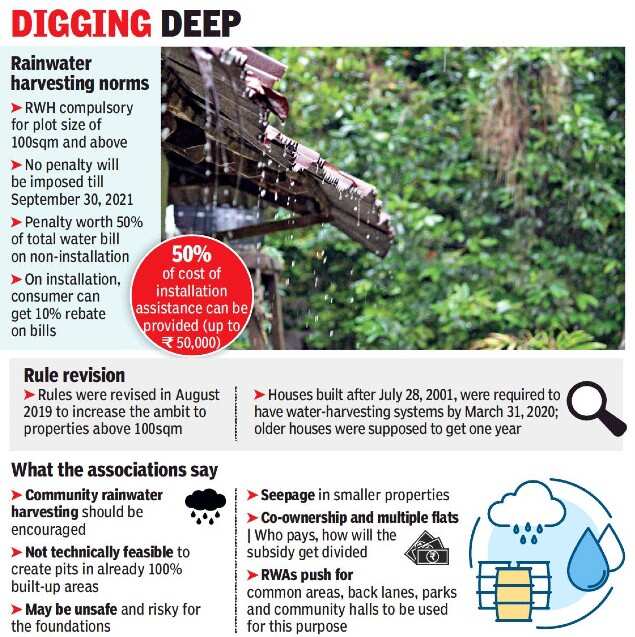Top Searches
- News
- City News
- delhi News
- Pitfall: Why residents are wary of new rules on tapping rainwater in Delhi
Pitfall: Why residents are wary of new rules on tapping rainwater in Delhi

Spread over 8,000 hectares, Delhi has more than 16,000 parks and open spaces where rainwater harvesting can be implemented
NEW DELHI: Many residents’ welfare associations have called for a review of the policy that makes it mandatory for properties above 100sqm to install rainwater harvesting (RWH) systems. In many cases, they argue, creating harvesting pits in already built-up areas of houses is not technically feasible and it may lead to weakening of the foundation because of seepage. RWAs have suggested that common areas, parks and back lanes can be used for developing common rainwater harvesting units.
The deadline for mandatory RWH installation is September 30, 2021.

Spread over 8,000 hectares, Delhi has more than 16,000 parks and open spaces where rainwater harvesting can be implemented with a potential of harvesting 12,800 million litres of rainwater every year, a CSE report states. The mandatory limit for individual houses was reduced from 500sqm to 100sqm by Delhi Jal Board in 2019.
Atul Goel, head of United Residents Joint Action Of Delhi, said that he had been contacted by RWAs with apprehension about the new limit. “How is it technically feasible to make RWH pits in already built-up structures? This is impractical and will lead to many issues. The policy should be reviewed. We should move towards community rainwater harvesting systems,” he added.
BM Bakshi, head of New Friends Colony RWA, seconded his views. “Where is the space in such small plots for the RWH system? The 100sqm limit is too low and it will lead to moisture in the foundation of the structures. The government should develop common rainwater harvesting pits with the help of RWAs where pipelines from rooftops of houses can be connected,” he suggested.
Bakshi further said that this would also lead to disputes between flat owners. “Ownership of flats on different floors in a building may be different and who will be held responsible in such cases?”
PK Paul, secretary of EBDP Association, which is an umbrella body for residents of CR Park, said that they had already expressed their objections to the new rules to DJB. “If we make pits inside a building, the discharge will lead to seepage and weaken the building’s foundation. Also, our colony buildings are on rock and it is not technically feasible to do it,” Paul stated.
He added that they had already set up eight RWH systems in parks on their own.
Chetan Sharma, general secretary of the confederation of NCR RWAs, said that the approach of backward integration was not legally sound. “The 100sqm limit covers almost all the planned Delhi properties. If government can allow mobile towers in parks, why not use them to develop rainwater harvesting structures. Instead of forcing the policy on 100sqm plots, large government and municipal properties should be covered first,” he added.
Water-deficient Delhi receives 617-670mm of average annual rainfall that can be used to recharge the depleting groundwater resources. However, most of it goes to waste every monsoon season. The deadline for mandatory RWH installation has seen several extensions in the past.
The deadline for mandatory RWH installation is September 30, 2021.

Spread over 8,000 hectares, Delhi has more than 16,000 parks and open spaces where rainwater harvesting can be implemented with a potential of harvesting 12,800 million litres of rainwater every year, a CSE report states. The mandatory limit for individual houses was reduced from 500sqm to 100sqm by Delhi Jal Board in 2019.
Atul Goel, head of United Residents Joint Action Of Delhi, said that he had been contacted by RWAs with apprehension about the new limit. “How is it technically feasible to make RWH pits in already built-up structures? This is impractical and will lead to many issues. The policy should be reviewed. We should move towards community rainwater harvesting systems,” he added.
BM Bakshi, head of New Friends Colony RWA, seconded his views. “Where is the space in such small plots for the RWH system? The 100sqm limit is too low and it will lead to moisture in the foundation of the structures. The government should develop common rainwater harvesting pits with the help of RWAs where pipelines from rooftops of houses can be connected,” he suggested.
Bakshi further said that this would also lead to disputes between flat owners. “Ownership of flats on different floors in a building may be different and who will be held responsible in such cases?”
PK Paul, secretary of EBDP Association, which is an umbrella body for residents of CR Park, said that they had already expressed their objections to the new rules to DJB. “If we make pits inside a building, the discharge will lead to seepage and weaken the building’s foundation. Also, our colony buildings are on rock and it is not technically feasible to do it,” Paul stated.
He added that they had already set up eight RWH systems in parks on their own.
Chetan Sharma, general secretary of the confederation of NCR RWAs, said that the approach of backward integration was not legally sound. “The 100sqm limit covers almost all the planned Delhi properties. If government can allow mobile towers in parks, why not use them to develop rainwater harvesting structures. Instead of forcing the policy on 100sqm plots, large government and municipal properties should be covered first,” he added.
Water-deficient Delhi receives 617-670mm of average annual rainfall that can be used to recharge the depleting groundwater resources. However, most of it goes to waste every monsoon season. The deadline for mandatory RWH installation has seen several extensions in the past.
FacebookTwitterLinkedinEMail
Start a Conversation
end of article

